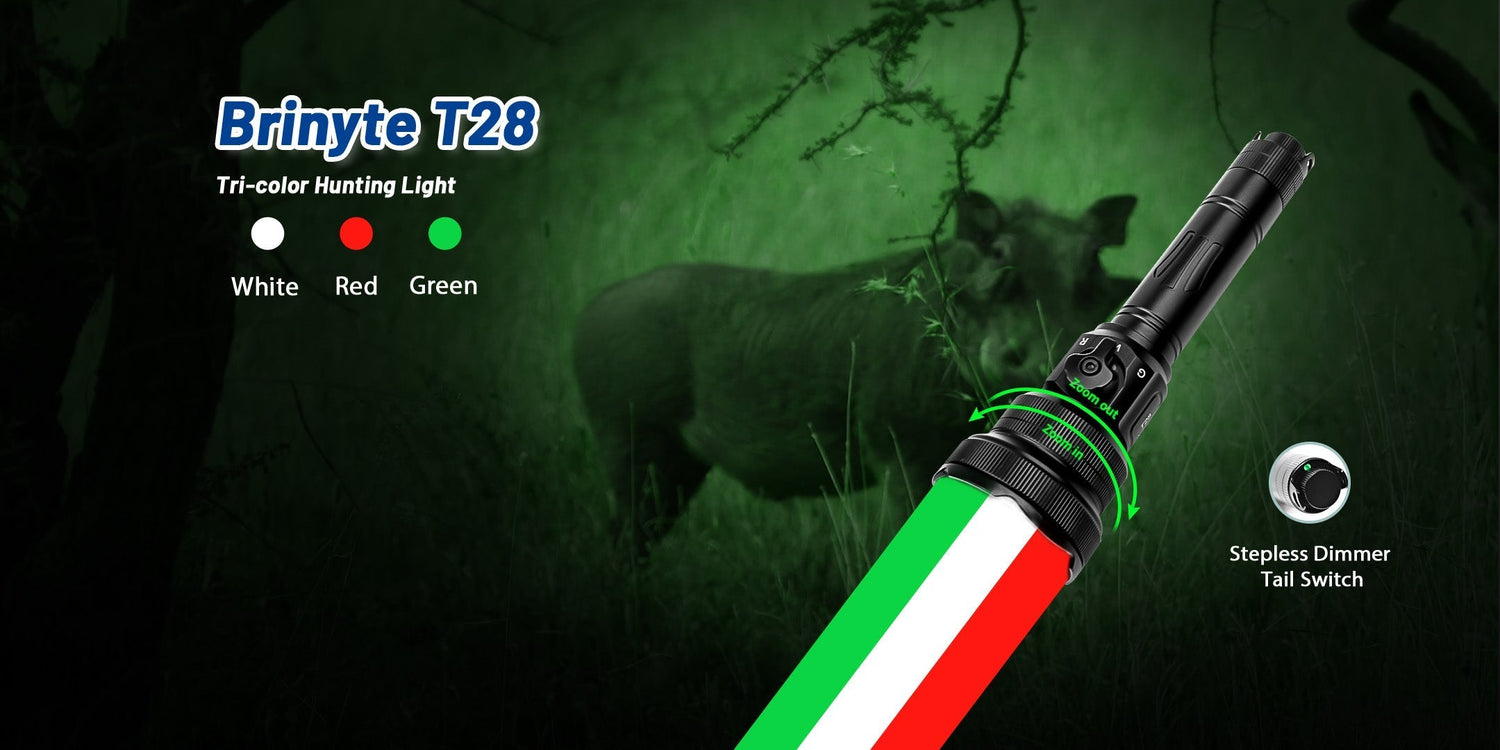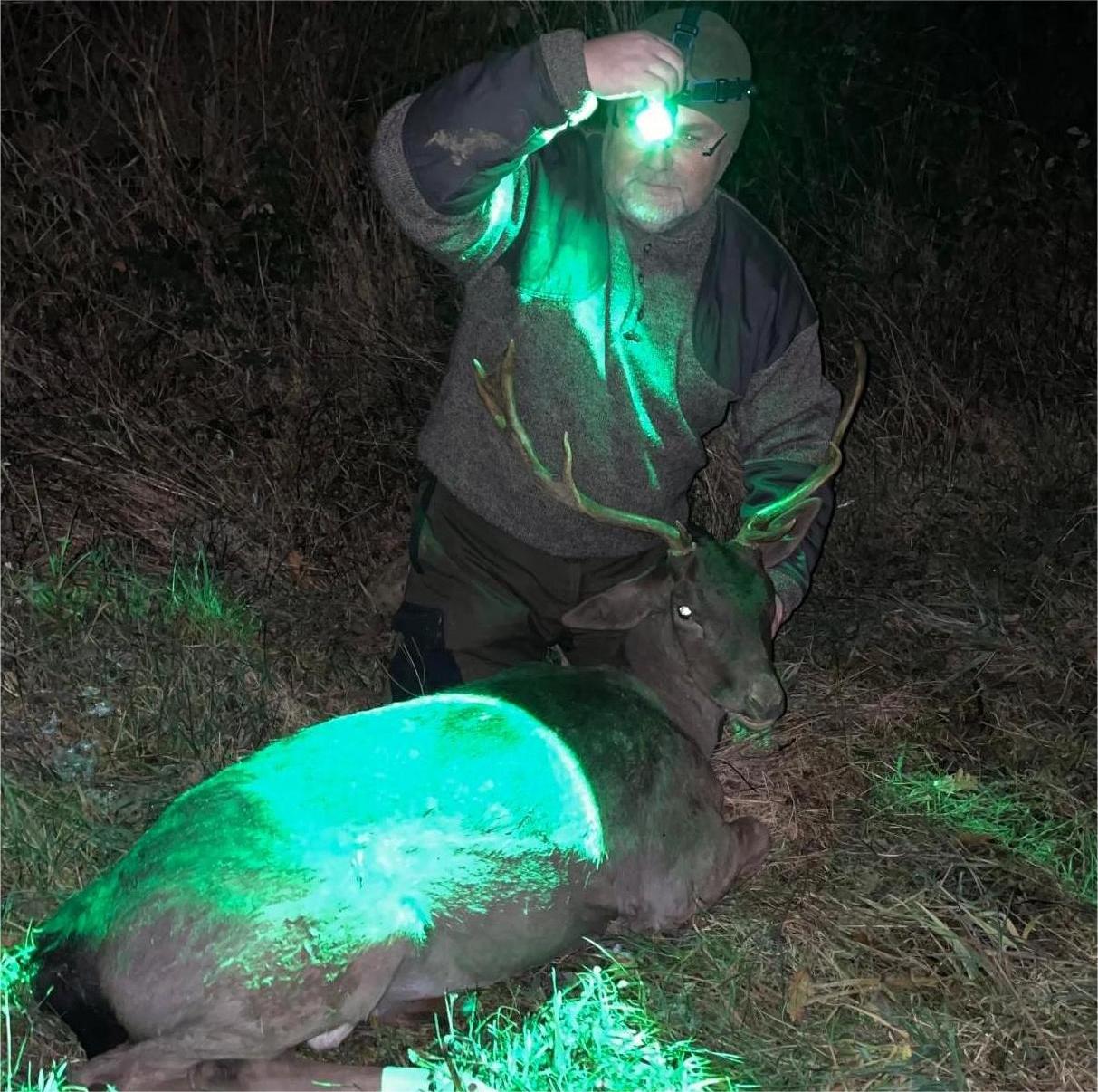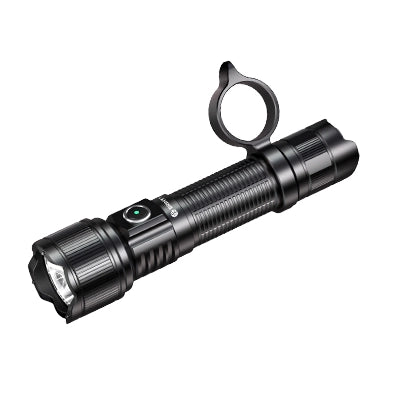The best light color for hunting depends on your goal:
- Red light for stealth approach and preserving night vision
- Green light for scanning fields without spooking game
- White light only for final identification shots
- UV/IR beams for blood tracking and night vision equipment
Smart hunters use red to move, green to scan, white to confirm, and UV/IR to recover game.
Introduction: Light Color Isn’t Just “Brightness”—It’s a Strategy
Most new hunters think “the brighter, the better,” but experienced hunters know that light color selection plays a direct role in detection, tracking, stealth, and animal behavior control.
Choosing the wrong beam color can spook game, ruin your setup, or expose your position—especially during night hunting or low-light ambush sessions.
This guide breaks down white, red, green, IR, and UV hunting beams, and shows how to use each one intelligently according to animal vision response and terrain conditions.
Understanding How Animals Perceive Light (Deer, Boar, Fox, Coyote Differences)
Not all game animals react to light in the same way:
| Animal | Color Sensitivity | Reaction to Light | Recommended Light |
| Deer | Limited red spectrum vision | Less spooked by red light | Red beam / Low-intensity white |
| Wild Boar | Easily startled by direct white beam | Aggressive when startled | Green or diffused red |
| Fox / Coyote | Extremely alert to movement under light | Avoid harsh white light | Green beam for scanning |
| Small Predators | Sensitive to heat and reflection | helps with blood tracking and night vision | UV for tracking / IR for thermal gear |

White Light – Best for Identification, Worst for Stealth
White light gives maximum brightness and clear target identification. It’s ideal for:
- Validating target identification before pulling the trigger
- Navigating dense forest paths
- Emergency signaling or rescue situations
But: it is the most likely to reveal your presence, especially during ambush hunting.
Pro Tip: Switch to low-lumen mode first, then burst into high lumen (like Brinyte T28’s high-candela throw mode) only for final confirmation.
Best moment to use white light:
Right before taking the shot or for safe navigation. Avoid continuous use during tracking or waiting.
Red Light – Stealth Tracking and Close-Range Observation
Red beam is one of the most preferred light colors among bow hunters and night stalkers.
Benefits
- Less disruptive to deer and most game animals
- Preserves human night vision
- Doesn’t reflect harshly off foliage or wet terrain
Best use cases
- Walking quietly to the hunting stand
- Reading maps or loading gear without lighting up the area
- Silent observation from a blind
Brinyte HC01 headlamp offers quick-switch red mode, making it an excellent silent movement companion.

Green Light – Long-Range Scanning Without Spooking Animals
Green light penetrates further in mist or forest edges, allowing hunters to scan fields without triggering immediate flight behavior.
Why experienced hunters love green beam
- Better contrast on fur and ground texture
- Less aggressive than white light but more visible than red
- Works well on boar, fox, coyote, and predator control
Example Gear: Brinyte HL28 Artemis, with its Tri-Color system (White / Red / Green), allows instant switching without losing aim or grip.

IR (Infrared) and UV Light – Advanced Tracking and Post-Shot Recovery
For hunters using thermal scopes, digital night vision, or tracking wounded game, IR/UV beams become extremely valuable.
| Light Type | Function | Best Use Case |
| IR (Infrared) | Invisible to the naked eye, visible under night vision scopes | Predator hunting with NV gear |
| UV (Ultraviolet) | Highlights blood traces and footprints | Post-shot tracking and recovery |
Most hunters overlook UV mode, but it dramatically reduces tracking time when blood trails are faint on ground leaves or snow.
Recommended Gear: Brinyte HL28 / T18 IR version for advanced NV-assisted hunts.
When to Switch Light Colors – Flow Strategy for Real Hunts
Here’s a pro-level light discipline sequence used by experienced night hunters:
- Navigate in Red → Scan in Green → Confirm with White → Track with UV/IR if hit
This minimizes detection risk while maximizing situational control.
Practical Scenario (Example):
- Approach stand quietly using red headlamp
- Spot movement across a field, switch to green scan mode
- Confirm target species and antler visibility with white momentary burst
- After the shot, scan with UV or IR to detect heat or blood

Brinyte Multi-Color Lighting Tools for Adaptive Hunting
| Model | Light Modes | Best For |
| Brinyte HL28 Artemis | White / Red / Green / UV | Versatile all-in-one for Nordic & US predator hunting |
| Brinyte HC01 | White + Red | Stealth navigation & close-range prep |
| Brinyte T18 Artemis | High-intensity long throw with IR optio | Extended-range scanning / night vision users |
| Brinyte T28 Oathkeeper | Precise beam control + color filters | Long-range identification with tactical control |
These models support one-hand color switching, preventing movement blur or noise that could alert nearby animals.
FAQ
1. What light color scares deer the least?
Red light is least likely to spook deer due to their limited red spectrum perception.
2. Is green or red better for hunting boar?
Green light offers better visibility for boar scanning without aggressive reaction.
3. Why use UV light in hunting?
UV illumination reveals blood trails and wound markers, helping locate game faster.
4. Can I hunt with white light?
Yes, but only for identification moments, not for approach or scanning.
5. Do headlamps with red mode help at night?
Yes, using red mode preserves your night vision, ideal for walking and prepping gear.
6. Should I invest in multi-color hunting flashlights?
If you hunt in varied terrain or target multiple species, multi-color lights like Brinyte HL28 or T18 offer tactical flexibility.
Conclusion – Light Color Isn’t Decoration, It’s a Hunting Tactic
Mastering light discipline isn’t just about theory—it’s a skill refined through the right tools and real field experience. Whether you rely on a headlamp for silent movement or a throw-style flashlight for scanning ridge lines, choosing purpose-built hunting gear makes every decision faster and safer.
Just like choosing the right caliber or camouflage, light discipline is a mark of an experienced hunter.
Pro Tip for Serious Hunters: If you're upgrading your setup for this season, explore the Brinyte hunting series like T18, T28, HL28, and HC01—designed with beam control, color filters, and cold-resistant runtime specifically for night hunting and harsh outdoor conditions.
Move smarter, light only what you need, and let your gear work as quietly and efficiently as you do.



